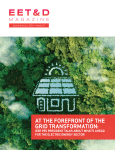The utility industry is facing a number of challenges. There is an urgent need to modernize to digitize the grid for reasons of operational efficiency, asset ownership and control. The grid is becoming more complex with increasing operational expenses. At the same time, many utilities have set ambitious Net Zero goals amid pressure from consumers and governments to decarbonize. Add to that, the demand for more reliable and higher quality power and a diversifying mix of intermittent resources —and the grid is ripe for a wholesale transformation.
There is potential here for telecom and power industries to come together and address all these challenges head-on. Mission-critical cellular networks providing grid connectivity can become that grid modernization mechanism that provides resiliency and flexibility for an evolving grid while reducing carbon emissions.
The future of the power grid is ever more a two-way street, where power is generated, stored and shared between multiple locations, creating energy savings as well as reducing the carbon footprint. Cellular connectivity at individual cell sites fortified with on-site Distributed Energy Resources (DER), linked together, can enable that future.
No intelligence without connectivity
The best possible path to meeting the aggressive goals set by utilities is through making the energy grid “smarter” — such as directing resources where and when they’re needed, and ramping down production when it’s not required. But there are degrees of intelligence, from simply demand response (DR) management to “self-healing” networks that take advantage of automation, to advance AI functionality that not only responds to peaks and valleys in demand but predicts them.
The key to that intelligence? Ubiquitous connectivity. And in the race to build a smarter grid, utilities have started down this path by building hundreds of mission-critical private cellular (4G or 5G) sites. It’s faster and more cost-effective than laying fiber, it’s secure and most importantly flexible enough to accommodate the deployment of future use cases or other “smart” solutions. The fast, high-bandwidth and low-latency connectivity these networks provide will enable the intelligence necessary to manage an increasingly complex grid. For example, sensors at substations connected to the network of cell sites via the 4G/5G networks across a region can help utilities shape their load profiles and energy-use profiles by collecting real-time data about the ebbs and flow of usage — as well as predicting when future peaks and valleys will occur. That intelligence is also critical for managing power consumption at the site itself, reducing energy usage and lowering costs as well as carbon emissions. This connectivity will be critical as utilities move to a decentralized model.
Nanogrids: The catalysts for an evolving power grid
The most important evolution of the utility industry is that soon, the majority of consumers will no longer simply consume energy but have the ability to create and share it too — as prosumers. This is happening today on a small scale, when for example residential solar owners sell excess production back to the grid, or with other microgrids.
As distributed generation gets even more granular, segments can be divided further from a microgrid into nanogrids. If a cluster of distributed energy resources (DER) systems comprises a microgrid, a nanogrid is one level below that — such as the power management infrastructure at a single cellular site, that can act as an on-demand resource to serve around 5-10 kilowatts for 12 hours or more.
Each of these cell sites can be an opportunity for the utility. Such a nanogrid site becomes one of the available energy resources in an overall network of hundreds of sites. They can draw power from on-site solar panels, battery storage systems, or other clean sources of power, replacing lead batteries and diesel generators. In addition, such a mechanism becomes key toward leveraging Ultra High-Voltage (UHV) transmission towers as potential cell sites, where secondary voltage may not be typically available to energize the 4G/5G electronics.
For example, one company’s headquarters in Plano, Texas has a new proof-of-concept 4G/5G site situated on its roof. The site has the ability to be fully powered by solar energy, complemented by integrated long-duration dual redundant battery storage units, for up to 18 hours. It brings together hybrid energy management, renewable energy sources and energy savings strategies while enhancing grid resiliency — and can be a model for broader partnerships between telecom and power interests.
Communications technologies and utilities must come together
Data from the U.S. Energy Information Administration shows that extreme weather driven by climate change is increasing power outages. We have witnessed catastrophic environmental disasters brought about by brushfires caused by downed conductors on the West Coast of the US.
Deeper collaboration between the communications and power grid infrastructure can help ensure no one is left vulnerable without power or connectivity in emergencies. But we need a system that welcomes flexibility in the power generation and distribution chain.
By decentralizing the power grid and connecting it with a global standards-based ubiquitous intelligent communications network, we can transform the existing power grid ecosystem to support digital transformation. And such nanogrids that leverage renewable sources and intelligent energy management systems will be an important building block for that transformation.
 Koustuv Ghoshal is vice president and the head of Ericsson North America’s Utilities and Energy verticals. Prior to this role, Koustuv was the VP and head of Ericsson’s management consulting division (inCode) for North America He brings over 30 years of experience in the utilities, telecom and mission-critical industry verticals. Before joining Ericsson, Ghoshal had P&L leadership roles at leading companies in the ICT domain. He has a bachelor’s degree in electrical engineering and a master’s degree in power systems automation from the University of Texas.
Koustuv Ghoshal is vice president and the head of Ericsson North America’s Utilities and Energy verticals. Prior to this role, Koustuv was the VP and head of Ericsson’s management consulting division (inCode) for North America He brings over 30 years of experience in the utilities, telecom and mission-critical industry verticals. Before joining Ericsson, Ghoshal had P&L leadership roles at leading companies in the ICT domain. He has a bachelor’s degree in electrical engineering and a master’s degree in power systems automation from the University of Texas.








